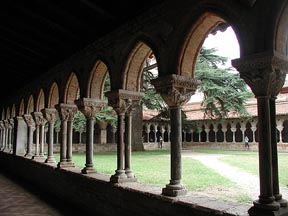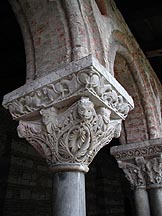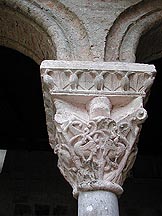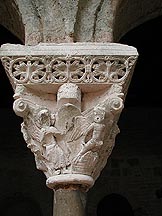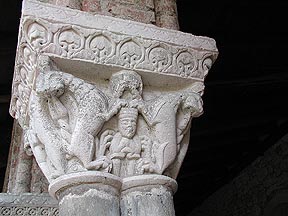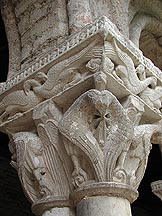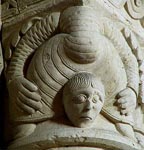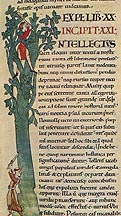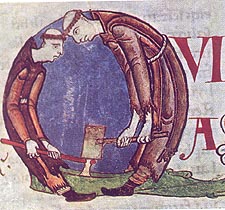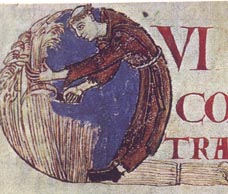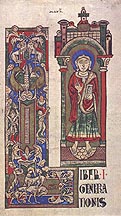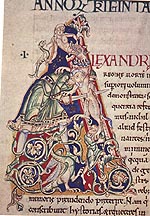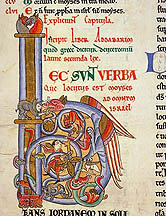Art Home | ARTH Courses | ARTH 212 Assignments
St. Bernard's Apologia
This text was written in 1124 by St. Bernard of Clairvaux, the primary voice of the Cistercian order. It is intended as an attack against the Cluniac order.
But these are small things; I will pass on to matters greater in themselves, yet seeming smaller because they are more usual. I say naught of the vast height of your churches, their immoderate length, their superflous breadth, the costly polishings, the curious carvings and paintings which attract the worshipper's gaze and hinder his attention....
But in the cloister, under the eyes of the Brethern who read there, what profit is there in those ridiculous monsters, in the marvellous and deformed comeliness, that comely deformity? To what purpose are those unclean apes, those fierce lions, those monstrous centaurs, those half-men, those striped tigers, those fighting knights, those hunters winding their horns? Many bodies are there seen under one head, or again, many heads to a single body. Here is a four-footed beast with a serpent's tail; there, a fish with a beast's head. Here again the forepart of a horse trails half a goat behind it, or a horned beast bears the hinder quarters of a horse. In short, so many and so marvellous are the varieties of divers shapes on every hand, that we are more tempted to read in the marble than in our books, and to spend the whole day in wondering at these things rather than in meditating the low of God. For God's sake, if men are not ashamed of these follies, why at least do they not shrink from the expense?
Compare the structure of this Roman Composite Capital to the structure of the Moissac Capitals.
Excerpt from Meyer Schapiro, "On the Aesthetic Attititude in Romanesque Art," originally published in 1947 revised and reprinted in Meyer Schapiro, Romanesque Art, 1977, pp. 1- 27: p. 8: [R]ecalling the monstrous sculptures of the cloisters, we are impressed by the fact that although Bernard condemns these works as meaningless and wasteful, he has written so vivid an inventory of their subjects and characterized them with such precision; every theme he mentions may be found in surviving Romanesque churches and cloisters. The saint has perused these capitals no less attentively than have the monds whom he reproaches for meditating the sculptures instead of the Bible or the Fathers. Only a mind deeply drawn to such things could recall them so fully; and only a mind with some affinity to their forms could apply to these carvings the paradoxical phrase: "that marvellous deformed beauty, that beautiful deformity (mira quaedam deformis formositas ac formosa deformitas)," which resembles in its chiasmic, antithetic pattern a typical design of Romanesque art....
/p.9: Bernard's writings are rich in figures of movement and life; he appeals constantly to metaphors of sensory delight for religious expression: "Jesus is honey on my lips, melody in my ears, jubilation in my heart." He loves striking contrasts, violent and astounding oppositions, the monstrous-grotesque, the antithetic and inverted. Thinking of his double life as monk and stateman of Christendom, he called himself: "the chimera of my age." The great heretic, Arnold of Brescia, he characterized with the fantasy of a Romanesque imagier: "head of a dove, tail of a scorpion." And when he had to speak of his own religious order, he imagined the Cistercians as acrobats and jongleurs of the spirit who provide a most beautiful spectacle to the angels, although they incur the contempt of the proud and worldly. "All that they [i.e., the worldly] desire, we on the contrary flee, and and they which they flee, we desire, like those jugglers and dancers, who, with head down and feet up, in an inhuman fashion stand or walk on their hands and attract the eyes of everyone."
This is an authentic image from Romanesque art. How often on the portals of southern and western France are there carved just such figures juxtaposed to holy personages --acrobats and dancers among fantastic beasts...!
Romanesque Historiated Initials
The vivid imagination evident in Romanesque historiated capitals like those from Moissac above is also evident in the historiated initials found in their manuscripts. Significantly the first three examples below come from a Cistercian book produced from the time of Bernard of Clairvaux. These initials seem in stark contrast to the austerity of Cistercian architecture and the attitudes expressed in Bernard's Apologia. On the other hand, these initials illustrate the Cistercian dedication to labor and the simplicity of their life. Like the capitals, note how the artists have adapted the figures to the structure of the initial.
